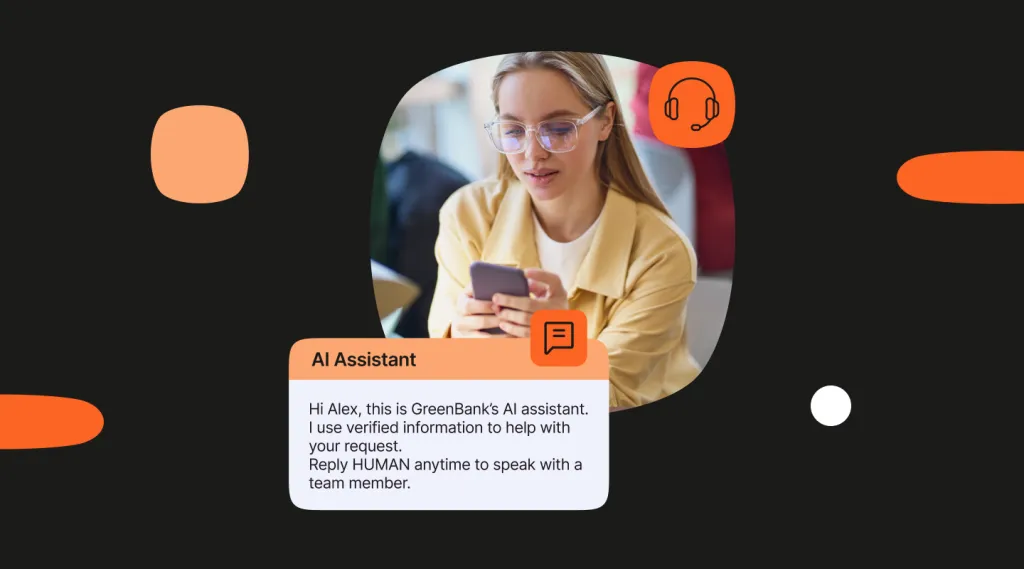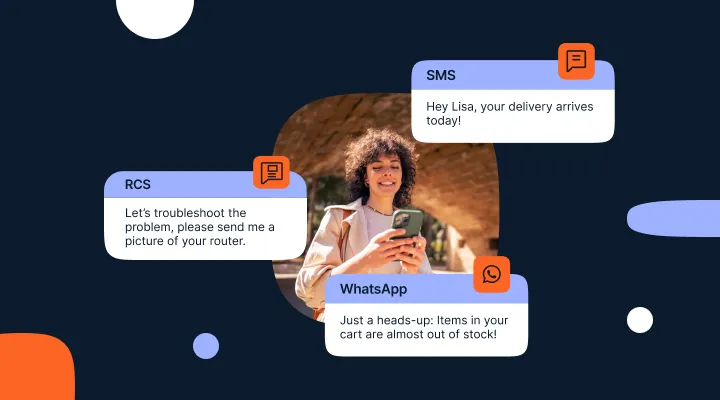How to get the benefits of generative AI without the risk
Everywhere you look, you see news about generative AI making mistakes and ruining the carefully curated reputations of brands that try to use it. Just this week a chatbot deployed by a major parcel delivery firm in the United Kingdom had to be withdrawn after a customer got it to swear and write a poem criticising the company.
These new stories fuel our distrust of AI and generative AI in particular. Recent research has shown that as many as 52% of Americans are worried about the uncontrolled growth of ‘bad’ AI used to impersonate people, scam, or threaten private information.
However, after learning more about AI technologies, most people see it as a tool to make their lives better – by making healthcare more accessible, speeding up customer support, and improving many other aspects of their personal and professional lives.
At Infobip we firmly believe that the future of artificial intelligence will be positive, but only if it is used responsibly and as a tool to help humans, rather than as a way of replacing them. In this article, you’ll learn about the many ways that generative AI can be used to improve our lives, without risking our jobs or the reputations of our business.
Business use cases for generative AI
AI technology has been hard at work for years, from personalizing your online shopping experience to helping to find the quickest route home during rush hour. But the fact that generative AI is now available to anyone that spends $20 a month for an OpenAI license means that the number of potential use cases has exploded.
But that doesn‘t mean that all use cases are suitable, at least not yet. The field of generative AI has developed so quickly that there have been some obvious growing pains. Just ask the CTO at that parcel delivery firm.
But there have also been some success stories, some of which Infobip has been directly involved with. So here we focus on how to get the gain without the pain.
Employee productivity and internal process improvements
We strongly recommed exploring how generative AI can be used internally within your organization before embarking on a full customer-facing project. In this way you can master the initial learning curve and make your mistakes behind closed doors without risking reputation or customer relationships.
Here are a few areas to explore.
Improved access to information
Most businesses collect a vast amount of data – from historical product information to customer purchase history and their past interactions with customer service. This data is only useful if it can be easily found and used to improve business processes or provide a better customer experience. This is where generative AI can be extremely useful by enabling anyone in your organization to request information using a conversational interface, without needing to know how to run queries on all the different databases in your organization.
Product development
Generative AI by its nature formulates output based on existing content, so by relying on it solely when developing new products, you will be reinventing the wheel and not coming up with anything original. However, it can be used very effectively as part of the product development process, for example:
- Grouping and summarizing customer feedback and requirements
- Generating multiple versions of prototypes by tweaking variables
- Creating visual representations of ideas and concepts based on textual descriptions.
- Spotting opportunities by predicting future trends using generative AI
- Spotting gaps or inconsistencies in product roadmaps.
Sales and marketing material
If you need to create a large volume of content quickly, then generative AI can be used to help. For example, summarizing product information for online catalogs, creating customer newsletters, social media updates, and the outlines for blog posts. We say help because generative AI should not be relied on to create this content by itself as you will end up with bland, repetative, and boring output.
One good use case is generating sales emails. If a human writes the copy for the base email in a human and engaging way, then generative AI can be used to peronalize it for every recipient based on their unique data. This is a perfect example of generative AI being used as a tool to improve the productivity of employees without replacing them or suppressing their creativity.
Gen AI tools like OpenAI can also be used to create images and other visual assets for marketing material and presentations. As ever, a human should be involved to ensure that they are appropriate and don‘t violate trademark or IP laws.
HR applications for generative AI
Virtual HR assistants
With so many people now working remotely it can be difficult for large organizations to provide an effective HR function for their employees. Generative AI can help in a number of ways:
- When onboarding new employees, provide information and training that is relevant to each person‘s location and job role.
- Keep employees updated on new policies and procedures.
- Help employees to find information that is owned by the HR team.
- Collate and summarize information and results for employee performance reviews.
However, it is important that a human HR specialist is always available when required.
Streamlining recruitment
Hiring new employees for your company is challenging and expensive. On average the hiring process can take around 30 days. But for some positions, it goes on for months. HR agents go through hundreds of resumes and schedule countless calls to find that one perfect fit.
Generative AI can speed up this process by scanning through pages and pages of data to identify ideal candidates based on their skills and qualifications.
Fraud detection and prevention
Flagging potential fraud
Generative AI is great at recognizing patterns and finding anomolies in vast amounts of data. It is therefore incredibly good at flagging discrepancies which might indicate fraudulent activity.
Safeguarding
For platform businesses and social media sites that require customers to create an account it is difficult to implement preventative measures to stop fraud. If caught, people breaking site rules can simply create a new account using another email address or phone number. Even blocking their IP address can be ineffective as they can just use a VPN to get around it. However, AI can be used to quickly identify these people based on their ‘digital fingerprint’ using a combination of data points like device, operating system, location, and time of day they access the site. Even their language and grammar usage can be used.
A good example is the measures put in place by dating websites to prevent romance fraud. The AI can detect activity that resembles fraud and either warn the potential victim or freeze the fraudster‘s account.
Improving customer service and experience
Once you are confident that you have the skills and experience to start using generative AI for external-facing use cases, there are a large number of areas where it can be effective.
Chatbots and virtual assistants
The most obvious customer experince role for generative AI is in the deployment of AI chatbots that help to provide a faster, always available, and ultimately more cost effective service to customers. And we can think beyond simple web chatbots and include virtual assistants deployed on chat apps, voice channels, and built into products themselves. Imagine a device, for example an exercise bike, that could train the user how to use it effectively and provide ongoing support and tailored advice throughout their fitness journey.
The key to avoiding a chatbot PR disaster is:
- Only train the AI with data that is relevant for your organization and obtained lawfully. Giving it access to external data sources, or to unvetted information from the web, increases the chances of nonsense output or responses that don‘t align with your brand values.
- Always include humans in the training process and make sure that you conduct thorough penetration testing (basically, try to make the AI slip up, because someone out there will try it).
We have lost count of the number of current AI lawsuits, and this will likely lead to changes in the way large language models are trained.
Personalization
Generative AI can be used to drive effective but also appropropriate personalization. Customer data is extracted from many sources, including direct customer feedback from surveys, social media comments, and call transcripts. AI can be used to implement a decison tree to help decide which data to use in the personalization process.
For example, imagine a supermarket chain personalizing offers to send to a customer. Zero-party data that they have voluntarily provided should trump first-party data that has been obtained through analyzing their previous transactions. Take the example of our exercise bike customer on a new year health drive – they may have a history of buying alcohol and unhealthy foods but could have told you that they have are now a teetotal vegetarian. It would be inappropriate to send them offers based on their previous lifestyle!
Campaign testing
Generative AI can make the lives of marketers and salespeople easier and significantly speed up the path to getting returns on marketing budget. Instead of spending weeks or even months testing different campaigns and waiting for results to come in, AI can continually monitor customer buying patterns and adapt campaigns that are in flight.
Examples of Generative AI in action
Customer support

LAQO Insurance
Learn how LAQO Insurance was able to provide 24/7 personalized support by adopting a GPT-enabled assistant for customer support using Infobip’s Gen-AI and Azure OpenAI Service.
Healthcare

Megi Health Platform
Read how the Megi Health Platform built a chatbot to supplement the work of health professionals by helping to gather important health data, provide tailored advice for each patient, and improve patient care.
Speak to an expert about how you can benefit from a generative AI solution.
Get in touch
What is ethical AI? Key principles, concerns, and ethical chatbots explained
Explore ethical AI principles and best practices for creating fair, transparent, and privacy-respecting chatbots.

The ultimate guide to generative AI chatbots for customer service
Learn how generative AI, agentic AI, and agentic RAG technology are transforming CX. Explore use cases, benefits, risks, and best practices.

Generative AI security: How to keep your chatbot healthy and your platform protected
Discover essential strategies to secure AI chatbots from evolving GenAI threats. Learn how to protect your AI investments now and keep them healthy and thriving.

Conversational AI vs. Generative AI: An in-depth comparison
Get an in-depth look at the difference between conversational AI vs. generative AI and how they can work together to help you elevate customer experiences.

Overhyped or underrated? Assessing the true impact of generative AI
As the buzz around GenAI starts to fizzle, has it lived up to our high expectations, and what does the future look like for GenAI?

Improve customer service through AI and keyword chatbots
Discover how AI and keyword chatbots can help you automate key elements of your customer service and deliver measurable impact for your business.







